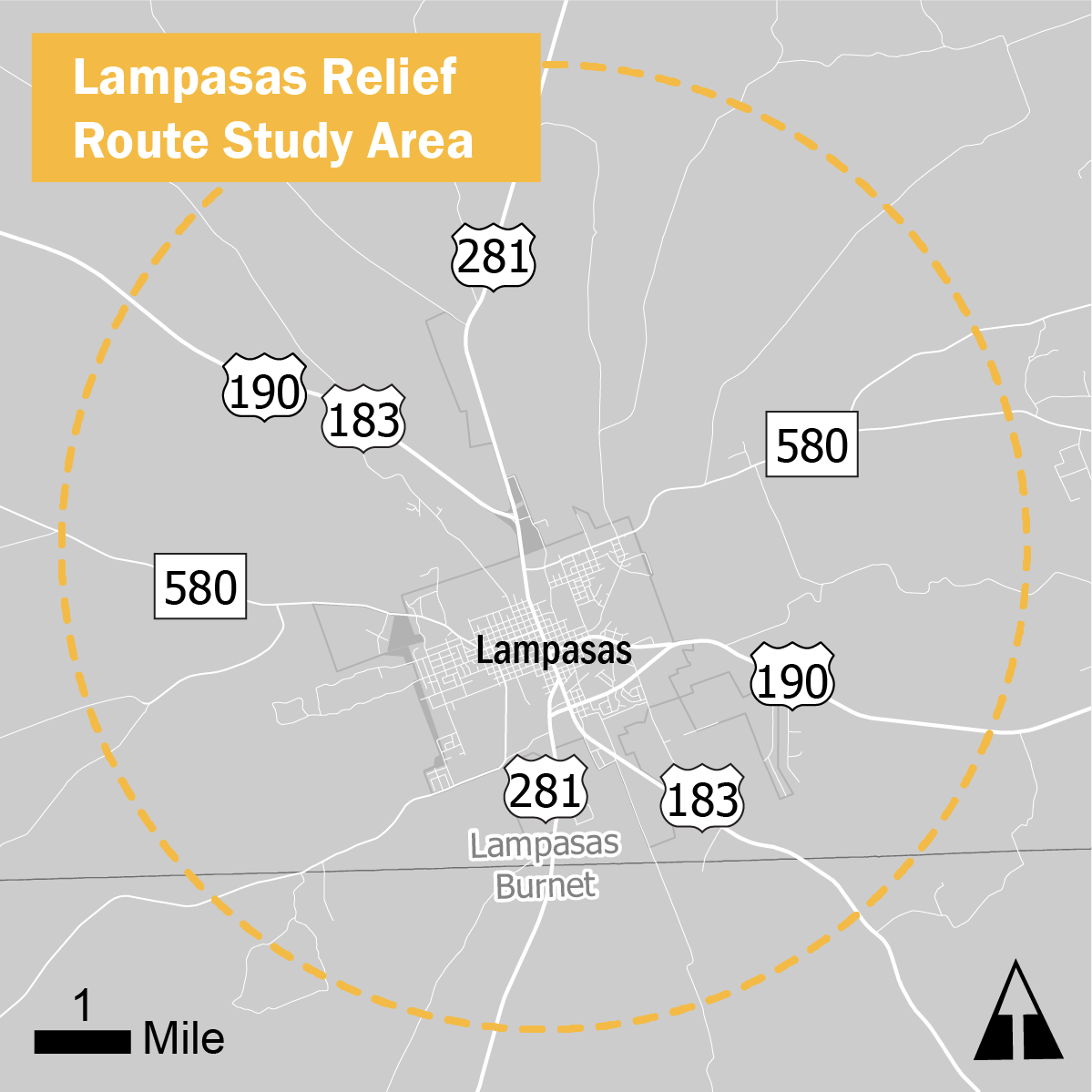Study overview
TxDOT, in coordination with the city of Lampasas, is conducting a feasibility study to explore a potential relief route around Lampasas. The relief route would give people the option to travel around the city.
The relief route study limits would connect US 281, US 183, and US 190 on the southern side of Lampasas to US 281 and US 183/US 190 on the northern side of Lampasas. The purpose of the relief route is to help reduce congestion, to improve safety and to improve mobility.
What is a feasibility study?
As part of the overall planning process, a feasibility study will help identify the purpose and need of a proposed relief route project to determine if it is environmentally and/or financially feasible. This early planning process can evaluate the project feasibility before starting the formal National Environmental Policy Act process. During the feasibility phase, an estimated cost and right-of-way width will be determined. Construction timing is not yet known.

Feasibility studies involve public input throughout. The studies assess current and projected population, traffic growth, and overall needs in the region. As part of the study, goals and objectives will be established and route options will be identified and evaluated. The study will conclude with the identification of a locally preferred option. If it is determined the option is feasible, TxDOT would consider developing a final alignment later as part of the engineering and NEPA processes.
Background
Currently, US 281, US 183, and US 190 traffic runs through the middle of Lampasas. A key objective of the study is to allow future through traffic, including trucks, to avoid central Lampasas while minimizing impacts to adjacent properties, railroads, utilities and the environment.
Discussions about a possible relief route have been ongoing with the city of Lampasas for several years. As traffic volumes and congestion continue to increase, the need for a relief route has become an important safety and quality-of-life issue for the community. Lampasas and its surrounding areas are a hot spot for recreational activities that dramatically increase traffic through the city on weekends. Lampasas is also feeling the effects of a growing population in the Austin and Copperas Cove/Killeen metropolitan areas with increased travelers and trucks providing service and goods through the city.
Schedule
The Lampasas Relief Route Feasibility study began in May 2022 and is anticipated to be complete in the Spring 2024. If the study concludes that a relief route is feasible, additional work will be needed on preliminary design, right-of-way needs, environmental study, and funding prior to a final relief route decision.
Public involvement
TxDOT is planning several public involvement opportunities during this early planning phase:
- The first Lampasas Relief Route Open House on June 28, 2022, will consider a wide study area around Lampasas and the public will provide input on potential route locations, as well as areas that should be avoided.
- As part of this open house effort, the Brownwood District offered an online engagement opportunity that encouraged the public to view an interactive study map area, draw their preferred relief route, answer survey questions and add their comments. This site was open for comments from June 9 to July 13, 2022. The public is still able to view the online engagement site, but the comment period is closed.
- A second Lampasas Relief Route Open House on Nov. 17, 2022, will present potential relief route conceptual route study areas based on input from the first public meeting.
- As of Feb. 2024, no preferred route has been identified and no further public meetings have been scheduled. The Brownwood district is currently focused on reviewing additional traffic analyses for the Lampasas Relief Route Study and the I-14 Route Study.
- An overall summary of the Lampasas Relief Route alternatives, based on comments received from the two previous public meetings, will be uploaded later this year.
Downloads
- Study Area Map
- First Public Meeting - June 28, 2022
- Second Public Meeting - Nov. 17, 2022